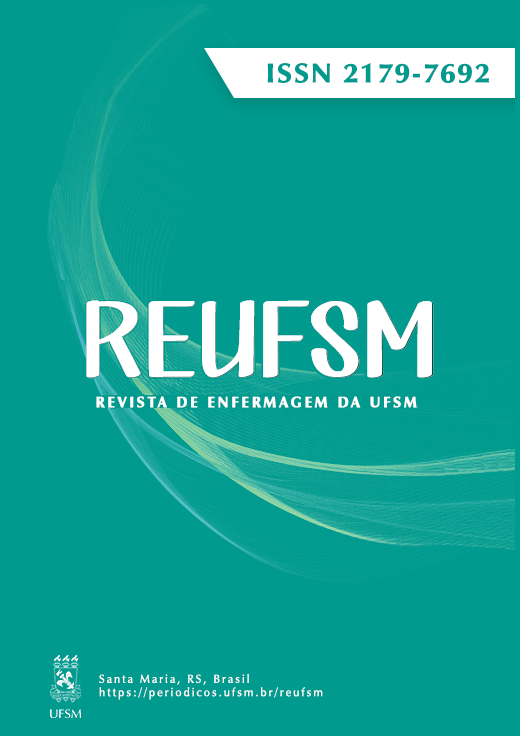Skin microclimate on heels: a within-person randomized clinical trial
DOI:
https://doi.org/10.5902/2179769285035Keywords:
Pressure Ulcer, Microclimate, Skin, Bandages, Clinical TrialAbstract
Objective: To evaluate the skin microclimate on the heels of patients hospitalized in an intensive care unit, using multi-layer polyurethane foam with silicone compared to transparent polyurethane film. Method: a within-person, parallel, randomized, clinical trial of superiority. Each patient received the experimental intervention (multi-layer polyurethane foam dressing with soft silicone) and the control intervention (transparent polyurethane film dressing), totaling 184 cutaneous sites (92 patients). The study was conducted in a university hospital in Santa Maria, Rio Grande do Sul State, from July 2017 to March 2018. Results: No statistically significant difference was identified regarding the temperature of the skin of the heels that developed pressure injuries (PIs), as well as of the heels using transparent polyurethane film between the initial and final assessment. Conclusion: The skin microclimate undergoes changes in its values when using dressings for PI prevention.
Downloads
References
European Pressure Ulcer Advisory Panel, National Pressure Injury Advisory Panel and Pan Pacific Pressure Injury Alliance. Prevenção e tratamento de úlceras/lesões por pressão: guia de consulta rápida. Ed. Port. Bras. Emily Haesler: EPUAP/NPIAP/PPPIA; 2019.
Araujo MT, Castanheira LS, Guimarães MCS, Silva YOW. Análise de custo da prevenção e do tratamento de lesão por pressão: revisão sistemátic. 2019 set 25;89(27). doi: 10.31011/reaid-2019-v.89-n.27-art.47 DOI: https://doi.org/10.31011/reaid-2019-v.89-n.27-art.47
Jia J, Li Z, Peng L. Early detection methods of deep tissue pressure injuries: a systematic review. J Shanghai Jiaotong Univ (Sci). 2022 nov 12;28:526-35. doi: 10.1007/s12204-022-2518-2 DOI: https://doi.org/10.1007/s12204-022-2518-2
Roaf R. The causation and prevention of bed sores. J Tissue Viability. 2006;16(2):6-8. doi: 10.1016/s0965-206x(06)62002-0 DOI: https://doi.org/10.1016/S0965-206X(06)62002-0
Schwartz D, Gefen A. An integrated experimental-computational study of the microclimate under dressings applied to intact weight-bearing skin. Int Wound J. 2020;17(3):562-77. doi: 10.1111/iwj.13309 DOI: https://doi.org/10.1111/iwj.13309
National Pressure Injury Advisory Panel (NPIAP). National Pressure Injury Advisory Panel (NPIAP) announces a change in terminology from pressure ulcer to pressure injury and updates the stages of pressure injury [Internet]. National Pressure Ulcer Advisory Panel: Washington (DC); 2016 [cited 2021 Apr 08]. Available from: http://www.npuap.org/national-pressure-ulcer-advisory-panel-npuap-announces-a-change-in-terminology-from-pressure-ulce r-to-pressure-injury-and-updates-the-stages-of-pressure-injury/
Wounds International. International review: Pressure ulcer prevention: pressure, shear, friction and microclimate in context: a consensus document [Internet]. London (UK): Wounds International ; 2010 [cited 2010 nov 21]. Available from: https://www.woundsinternational.com/resources/details/international-review-pressure-ulcer-prevention-pressure-shear-friction-and-microclimate-context
Greenwood C. Heel pressure ulcers: understanding why they develop and how to prevent them. Nurs Stand. 2022 Feb;37(2):60-6. doi: 10.7748/ns.2021.e11740 Epub 2021 Dec 13 PMID: 34898093 DOI: https://doi.org/10.7748/ns.2021.e11740
Dube A, Sidambe V, Verdon A, Phillips E, Jones S, Lintern M, et al. Risk factors associated with heel pressure ulcer development in adult population: a systematic literature review. J Tissue Viability 2022 Feb;31(1):84-103. doi: 10.1016/j.jtv.2021.10.007 DOI: https://doi.org/10.1016/j.jtv.2021.10.007
Amrani G, Peko L, Hoffer O, Ovadia-Blechman Z, Gefen A. The microclimate under dressings applied to intact weight-bearing skin: infrared thermography studies. Clin Biomech. 2020;75:104994. doi: 10.1016/j.clinbiomech.2020.104994 DOI: https://doi.org/10.1016/j.clinbiomech.2020.104994
Hochman B, Nahas FX, Oliveira-Filho RS, Ferreira LM. Desenhos de pesquisa. Acta Cir Bras. 2005;20(Supl 2):2-9. doi: 10.1590/S0102-86502005000800002 DOI: https://doi.org/10.1590/S0102-86502005000800002
Bernades RM, Caliri MHL. Pressure ulcer prevalence in emergency hospitals: a cross-sectional study. Online Braz J Nurs. 2016;15(2):236-44. doi: 10.17665/1676-4285.20165391 DOI: https://doi.org/10.17665/1676-4285.20165391
Yusuf S, Okuwa M, Shigeta Y, Dai M, Iuchi T, Rahman S, et al. Microclimate and development of pressure ulcers and superficial skin changes. Int Wound J. 2015;12(1):40-6. doi: 10.1111/iwj.12048 DOI: https://doi.org/10.1111/iwj.12048
Niu HH, Lui PW, Hu JS, Ting CK, Yin YC, Lo YL, et al. Thermal symmetry of skin temperature: normative data of normal subjects in Taiwan. Zhonghua Yi Xue Za Zhi (Taipei). 2001 Aug;64(8):459-68 PMID: 11720145
Mukaka MM. A guide to appropriate use of Correlation coefficient in medical research. Malawi Med J [Internet]. 2012 [cited 2020 jan 21];24(3):69-71. Available from: https://www.ncbi.nlm.nih.gov/pmc/articles/PMC3576830
Lichterfeld‐Kottner A, Vogt A, Tomova‐Simitchieva T, Blume‐Peytavi U, Kottner J. Effects of loading and prophylactic dressings on the sacral and heel skin: an exploratory cross‐over trial. Int Wound J. 2021;18(6):909-22. doi: 10.1111/iwj.13596 DOI: https://doi.org/10.1111/iwj.13596
Yoshimura M, Nakagami G, Iizaka S, Yoshida M, Uehata Y, Kohno M, et al. Microclimate is an independent risk factor for the development of intraoperatively acquired pressure ulcers in the park-bench position: a prospective observational study. Wound Repair Regen. 2015;23(6):939-47. doi: 10.1111/wrr.12340 DOI: https://doi.org/10.1111/wrr.12340
Temel M, Johnson AA, Lloyd AB. Evaluating the repeatability of friction coefcient measurements and tactile perceptions in skin–textile interactions across body regions. Tribol Lett [Internet]. 2022 Jan;70(23). doi: 10.1007/s11249-021-01560-5 DOI: https://doi.org/10.1007/s11249-021-01560-5
Mifsud T, Modestini C, Mizzi A, Falzon O, Cassar K, Mizzi S. The effects of skin temperature changes on the integrity of skin tissue: a systematic review. Adv Skin Wound Care. 2022 Oct 01;35(10):555-65. doi: 10.1097/01.ASW.0000833612.84272.da Epub 2022 Jul 04 DOI: https://doi.org/10.1097/01.ASW.0000833612.84272.da
Gefen A, Cohen LP, Amrani G, Hoffer O, Ovadia-Blechman Z. The roles of infrared thermography in pressure ulcer research with focus on skin microclimate induced by medical devices and prophylactic dressings. Wounds Int [Internet].2019 [cited 2023 mai 29];10(1):8-15. Available from: https://woundsinternational.com/wp-content/uploads/sites/8/2023/02/5f958a872d64bd831beff058a6ac9b36.pdf
Bhargava A, Chanmugam A, Herman C. Heat transfer model for deep tissue injury: a step towards an early thermographic diagnostic capability. Diagn Pathol. 2014 Feb;20(9):36. doi: 10.1186/1746-1596-9-36 DOI: https://doi.org/10.1186/1746-1596-9-36
Tarigan S, Yusuf S, Syam Y. Effect of interface pressure and skin surface temperature on pressure injury incidence: a turning schedule pilot study. J Wound Care. 2021 Aug 02;30(8):632-41. doi: 10.12968/jowc.2021.30.8.632 PMID: 34382846 DOI: https://doi.org/10.12968/jowc.2021.30.8.632
Soares RS, Lima SB, Eberhardt TD, Rodrigues LR, Martins RS, Silveira LB, et al. Skin temperature as a clinical parameter for nursing care: descriptive correlational study. J Wound Care. 2019;28(12):835-41. doi: 10.12968/jowc.2019.28.12.835 DOI: https://doi.org/10.12968/jowc.2019.28.12.835
Moore Z, Patton D, Rhodes SL, O’Connor T. Subepidermal moisture (SEM) and bioimpedance: a literature review of a novel method for early detection of pressure-induced tissue damage (pressure ulcers). Int Wound J. 2017;14(2):331-7. doi: 10.1111/iwj.12604 DOI: https://doi.org/10.1111/iwj.12604
Kottner J, Dobos G, Andruck A, Trojahn C, Apelt J, Wehrmeyer H, et al. Skin response to sustained loading: a clinical explorative study. J Tissue Viability. 2015;24(3):114-22. doi: 10.1016/j.jtv.2015.04.002 DOI: https://doi.org/10.1016/j.jtv.2015.04.002
Downloads
Published
How to Cite
Issue
Section
License
Copyright (c) 2024 Revista de Enfermagem da UFSM

This work is licensed under a Creative Commons Attribution 4.0 International License.
This work is licensed under a Creative Commons Attribution-NonCommercial-ShareAlike 4.0 International License.








